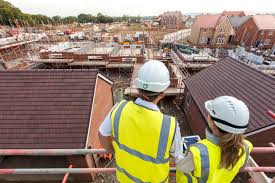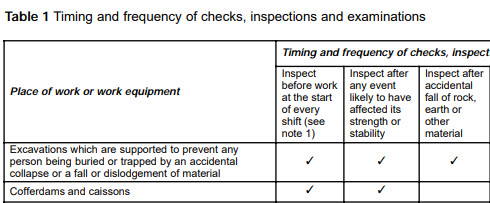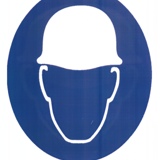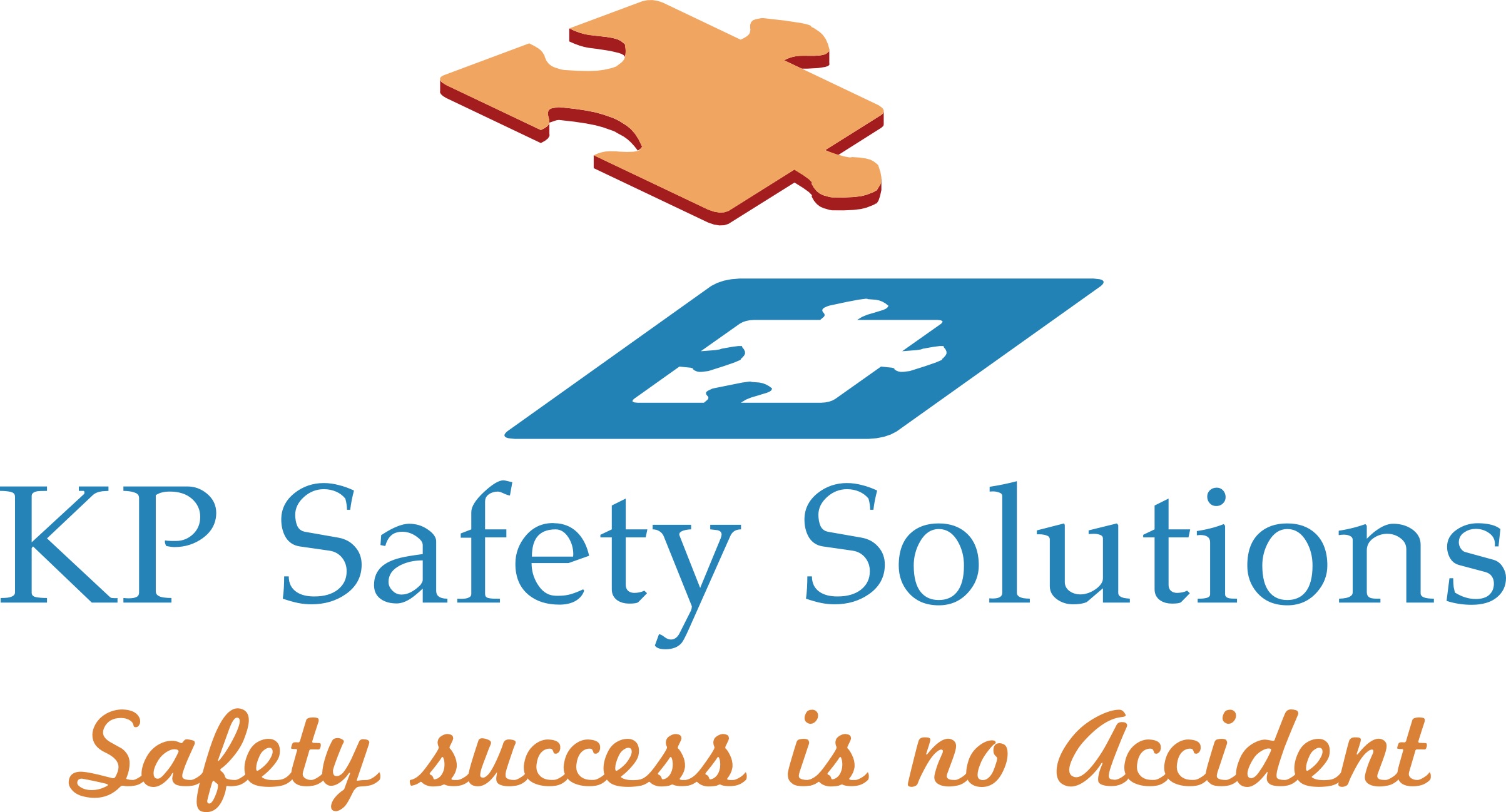Information
-
Location
-
Client
-
Date
-
Prepared by
-
Client Personnel
Previous actions
Previous site action
-
Have previous corrective actions been completed?
-
No previous actions exist.
-
Outstanding actions can be seen as a companies failure to manage identified hazards. This could count against the company if there were to be an incident on site. https://www.sentencingcouncil.org.uk/wp-content/uploads/Health-and-Safety-Corporate-Manslaughter-Food-Safety-and-Hygiene-definitive-guideline-Web.pdf
Site controls
Review site controls
-
Site entrance suitable and safe.
-
There should be safe access onto and around the site for people and vehicles.
Plan how vehicles will be kept clear of pedestrians, especially at site entrances where it may be necessary to provide doors or gates to achieve this segregation. Doors that open onto traffic routes may need viewing panels or windows. -
Doors that open onto traffic routes may need viewing panels or windows.
-
Site signage adequate with appropriate information and directions.
-
Signs should be clear and promenant. Signs should include the required PPE, Contact details and directions to the site office.
-
Access to the site office can be obtained via a safe route.
-
Plan how vehicles will be kept clear of pedestrians, especially at site entrances where it may be necessary to provide doors or gates to achieve this segregation. Doors that open onto traffic routes may need viewing panels or windows.
-
Site secure with sufficient controls in place.
-
Construction work should be fenced off and suitably signed. This will protect people (especially children) from site dangers and the site from vandalism and theft.. This is generally achieved by erecting a 2 m high perimeter fence or hoarding. Make sure there is a system to ensure necessary precautions are kept in place during working hours and that night-time and weekend protection is put in place as required before the site closes.
-
Plant, equipment and tools stored securely.
-
Construction site security is vital in order to deter intruders, prevent theft, and detect vandalism or wilful damage. Construction site security systems are being used by companies concerned about the health and safety implications of unauthorised entry into buildings or construction sites. CCTV or remote monitoring can help protect expensive equipment.
https://www.bsia.co.uk/Portals/4/Publications/123-construction-site-security-a-guide.pdf -
Documentation
Review of documentation.
-
Required documentation such as F10, insurance etc are displayed.
-
There are certain things that should be displayed in the site office. These include, Health & safety Law Poster, F10, Accident book, Site emergency procedures, Health & Safety Policy and Liability Insurance Certificate.
Other thinks that can be displayed are the Fire Evacuation plan and Emergency map marking Fire points, Assembly Points, First aid locations, Health & Safety Inspection Records, Plant & Equipment Register with PAT Test reports, Permits to Work and List of Required PPE -
Site register maintained and up to date.
-
In the event of an emergency there is a requirement to ensure all persons on site are accounted for. The site sign in / register is maintained to ensure this can be done.
-
Site inductions up to date.
-
The induction is important as all sites are different and have a wide range of hazards which will change as the site develops
The site induction must be specific to the site and provides workers with information on the current hazards of the site and tells
them about the site rules. This is important to set out the standards that are required right at the start -
Risk assessments up to date and appropriate.
-
HSWA section 3 places general duties on employers and the self-employed to conduct their undertakings in such a way as to ensure, so far as is reasonably practicable, that persons other than themselves or their employees are not exposed to risks to their health or safety. Failure to complete suitable & sufficient risk assessments is part of that process. http://www.hse.gov.uk/managing/delivering/do/profiling/the-law.htm
-
Method statements up to date and appropriate.
-
The arrangements for carrying out demolition, dismantling or structural alteration must be recorded in writing before the work begins. This is usually achieved by means of a method statement that can be generated from a risk assessment. Such statements are prepared for many higher risk construction activities eg roof work
-
Employees briefed and signed on to the documentation.
-
To achieve success in health and safety management, there needs to be effective communication up, down and across the organisation.
Organisations need to communicate information to their workers on the risk to their health and safety identified in their risk assessments, and the preventive and protective measures necessary to control risk.
The information provided should be communicated appropriately, taking into account:
workers’ levels of competence
the size and structure of the organisation -
Employees competencies available.
-
As an employer, you must ensure that any individual performing a task on your behalf has the competence to do so without putting the health and safety of themselves or others at significant risk. Ensuring copies of their competence are available on site either electronically or paper copies makes it easier to manage and helps ensure only trained and competent persons are working on site.
General procedures
General & Emergency procedures.
-
Are adequate fire precautions in place including assembly point, alarm and fire fighting equipment/
-
Legislation requires a suitable and sufficient fire risk assessment to be carried out by a responsible person (the employer or persons in control). The FSO places responsibility for compliance on the ‘responsible person’. Article 3 defines the responsible person as:
■ the employer (for a workplace to any extent under the employer’s control); or
■ a person who has control of a premises in connection with them carrying out any trade, business or other undertaking (for profit or not); or
■ the owner, where the person in control of the premises does not have control in connection with the carrying on by that person of any trade, business or other undertaking.
http://www.hse.gov.uk/pubns/priced/hsg168.pdf -
Escape routes clear and unobstructed.
-
Escape routes need to be available for everyone on the site. On open-air sites and unenclosed, single-storey structures, such routes may be both obvious and plentiful. However, in more complicated structures, especially where work is above or below ground, more detailed consideration will be needed:
-
Have there been any accidents or incidents?
-
Enter details of accident or incident.
-
First aid box stocked and appropriate.
-
The Health and Safety (First-Aid) Regulations 1981 require employers to provide adequate and appropriate equipment, facilities and personnel to ensure their employees receive immediate attention if they are injured or taken ill at work. These Regulations apply to all workplaces including those with less than five employees and to the self-employed.
What is ‘adequate and appropriate’ will depend on the circumstances in the workplace. This includes whether trained first-aiders are needed, what should be included in a first-aid box and if a first-aid room is required. -
Trained first aider on site
-
Name
-
The Health and Safety (First Aid) Regulations 1981 require all construction sites to have:
A first aid box with enough equipment to cope with the number of workers on site;
An appointed person to take charge of first-aid arrangements; and
Information telling workers the name of the appointed person or first aider and where to find them. A notice in the site hut is a good way of doing this. -
Permit procedures necessary.
-
Permit types used.
- Working at height
- Excavation
- Live working
- Confined spaces
- Asbestos
- Hot work
- Other
-
Permits used effectively
-
Permit to work (PTW) systems are formal procedures used to control activities that are considered high-risk. Permits only allow authorised personnel to perform those activities at specified times and in a way set out in the permit and referenced documents.
A permit to work might be required for activities such as:
Electrical works.
Hot works.
Excavation.
Lifting operations.
Work in confined spaces.
Work at height.
Work to roofs.
Temporary works.
Work with asbestos.
Demolition. -
COSHH documentation available.
-
Documentation available.
- MSDS
- Risk assessments
-
Construction work can involve a number of hazardous substances. The sections below provide more information about what you need to know and do.
Key points – construction workers are exposed to a number of hazardous substances. Be aware of the significance of the ill health effects these cause and the main risk factors behind them.
Construction dust - construction dust is not just a nuisance; it can be a real risk to your lungs.
Cement - cement based products, like concrete or mortar, can cause serious skin problems such as dermatitis and burns.
Lead - lead is still commonly used and found in older buildings. Breathing in lead dust and fume inadvertently or swallowing it can cause serious health problems.
Solvents - solvents are found in many products such as paints, thinners, resins and glues. Poorly controlled work with solvents can create both short-term ill-health effects and longer term disease.
Isocyanates - products that contain isocyanates include paints, coatings, foams and glues. Exposure to isocyanates can create a risk of asthma and dermatitis.
Harmful micro-organisms - construction workers can be exposed to a variety of disease causing micro-organisms such as bacteria, viruses and fungi. They can be transmitted through the air, by hand to mouth contact or through the skin and lead to a range of health problems.
Carbon monoxide (CO) - this is a colourless and tasteless poisonous gas produced by gas appliances and engines when there is not sufficient air for them to work correctly. Carbon monoxide can kill. -
Chemicals adequately controlled.
-
See information above. For more details see http://www.hse.gov.uk/coshh/basics.htm
Sub-contractors
-
Are sub-contractors being used?
-
Are the competencies of the sub contractors available and checked?
-
Have the sub-contractors RAMS been approved and are they available on site.
-
The contractor must assess the risks for the contracted work and then both of you must get together to consider any risks from each other’s work that could affect the health and safety of the workforce or anyone else
-
Are sub-contractor interactions controlled effectively?
-
You should set up liaison arrangements for co-operation and co-ordination with all those responsible to ensure the health and safety of everyone in the workplace and decide what you need to do to manage and supervise the work of contractors and agree the nature of the controls before work starts
-
No sub-contractors on site.
Housekeeping
Housekeeping
-
Good housekeeping being observed
-
Most slips occur in wet or contaminated conditions and most trips are due to poor housekeeping. Slips and trips are the most common cause of major injuries at work and can happen almost anywhere. 95% of major slips result in broken bones and they can also be the initial cause for a range of other types of accident such as a fall from height.
The Management of Health and Safety at Work Regulations 1999 (Regulation 3) builds on the HSWA and include duties on employers to assess risks (including slip and trip risks) and take action where necessary.
The Workplace (Health, Safety and Welfare) Regulations 1992 (Regulation 12) require floors to be suitable, in good condition and free from obstructions. People should be able to move around safely. -
Walkways free of trip (Alpha) hazards.
-
Goods stored safely to prevent falling onto persons
-
A third of the injuries are caused by falling objects (eg an item falling from a storage rack), a quarter are from hand tools.
PPE
PPE
-
Appropriate PPE identified.
-
Required PPE
- Safety footwear
- LEP
- Hard Hat
- Glove
- Goggles
- Hi Vis
- Task specific
-
Good compliance observed.
-
PPE should be used as a last resort. Wherever there are risks to health and safety that cannot be adequately controlled in other ways, the Personal Protective Equipment at Work Regulations 1992 require PPE to be supplied. The Regulations also require that PPE is:
■ properly assessed before use to make sure it is fit for purpose;
■ maintained and stored properly;
■ provided with instructions on how to use it safely;
■ used correctly by employees.
Occupational Health Hazards
-
What occupational hazards exist?
- Asbestos
- Noise
- Vibration
- Weils Disease
- Dust
-
Is an asbestos register available?
-
There is a legal presumption that any non-domestic premises built before 2000 contain asbestos. Under the Control of Asbestos Regulations 2012, SI 2012/632, the 'dutyholder' must carry out a 'suitable and sufficient assessment' to establish whether asbestos is present in non-domestic premises.
If working in a domestic premises there is still a requirement under the Health & Safety at Work etc Act 1974 Employers Duties
To conduct their work in such a way that their employees will not be exposed to health and safety risks.
The refurbishment / demolition survey is required where the premises, or part of it, need upgrading, refurbishment or demolition. The survey does not need a record of the condition of asbestos-containing materials (ACM). Normally, a surveyor is needed for refurbishment / demolition surveys.
A Refurbishment / demolition survey aims to ensure that:
nobody will be harmed by work on ACM in the premises or equipment;
such work will be done by the right contractor in the right way
The survey must locate and identify all ACM before any structural work begins at a stated location or on stated equipment at the premises. It involves destructive inspection and asbestos disturbance. The area surveyed must be vacated, and certified 'fit for reoccupation' after the survey. -
Has the relevant level of survey been completed?
-
-
A refurbishment / demolition survey is required where the premises, or part of it, need upgrading, refurbishment or demolition. The survey does not need a record of the condition of asbestos-containing materials (ACM). Normally, a surveyor is needed for refurbishment / demolition surveys.
A Refurbishment / demolition survey aims to ensure that:
nobody will be harmed by work on ACM in the premises or equipment;
such work will be done by the right contractor in the right way
The survey must locate and identify all ACM before any structural work begins at a stated location or on stated equipment at the premises. It involves destructive inspection and asbestos disturbance. The area surveyed must be vacated, and certified 'fit for reoccupation' after the survey. -
Is noise being effectively managed?
-
Where your employees are likely to be exposed at or above the upper exposure action value, you must take action to reduce noise exposure with a planned programme of noise control. Some tasks with indicative noise levels at or above the upper exposure action value are given below.
Carpentry 92
Concrete
chipping / drilling 85+
floor finishing 85
grinding 85
concrete worker 89
Driving a dumper or roller 85+
Formwork 92
concrete pour 97
digging / scabbling 100
shovelling hardcore 94
shuttering 91
angle grinding / cutting 100+ -
Is vibration being effectively managed?
-
Exposure to vibration when using hand held / operated tools and machinery can lead to permanent injury of the hands and arms. The Control of Vibration at Work Regulations 2005 says you must prevent or reduce risks from exposure to vibration at work. Follow the Assess, Control and Review model. Construction sites have a range of different activities involving vibrating tools and machinery. Check out the HSE's Vibration calculator, http://www.hse.gov.uk/vibration/hav/hav.xlsm
-
Is Weils Disease being effectively managed?
-
Construction workers may be exposed to a type of Leptospirosis called Weil’s Disease. The risk of Weil’s disease is linked to areas where rats are or have been present. Work is considered higher risk where there is evidence of rat infestation.
wearing protective clothing like gloves
Follow good basic hygiene including regular hand-washing and avoiding hand to mouth/eye etc contact
Take rest breaks, including meals and drinks, away from the work area;
Wash cuts and grazes immediately with soap and running water Cover all cuts, abrasions and other breaks in the skin with waterproof dressings and/or gloves. -
Is Dust being effectively managed?
-
Construction dust is not just a nuisance; it is a real risk to your lungs. Regularly breathing construction dust can cause diseases like lung cancer, asthma, Chronic Obstructive Pulmonary Disease (COPD) and silicosis. Construction workers have a high risk of developing these diseases because many common construction tasks can create high dust levels.
These diseases cause permanent disability and early death. Over 500 construction workers are believed to die from exposure to silica dust every year.
Working at height
Working at height.
-
Is there any working at height?
-
Is safe working at height available and by what means. (S)caffold, (T)ower, (P)odium/steps or (M)ewps
- Fixed scaffold
- Tower scaffold
- MEWP
- Podiums / Steps / Trestles
- Ladders
- Personal fall protection
- Roof work
- Other
-
Is working at height adequately controlled?
-
Working at height remains one of the biggest causes of fatalities and major injuries. Common cases include falls from ladders and through fragile surfaces. ‘Work at height’ means work in any place where, if there were no precautions in place, a person could fall a distance liable to cause personal injury (for example a fall through a fragile roof).
The Regulations apply to all work at height where there is risk of a fall that is liable to cause personal injury. They place duties on employers, the self-employed and any person who controls the work of others (such as facilities managers or building owners who may contract others to work at height).
Those with duties under the Working at Height Regulations 2005 must ensure that:
all work at height is properly planned and organised
those involved in work at height are competent
the risks from work at height are assessed, and appropriate work equipment is selected and used
the risks of working on or near fragile surfaces are properly managed
the equipment used for work at height is properly inspected and maintained
Fixed Scaffold
-
Is scaffold in good condition and free from defects?
-
It is a requirement of the Work at Height Regulations 2005 that unless a scaffold is assembled to a generally recognised standard configuration, eg NASC Technical Guidance TG20 for tube and fitting scaffolds or similar guidance from manufacturers of system scaffolds, the scaffold should be designed by bespoke calculation, by a competent person, to ensure it will have adequate strength, rigidity and stability while it is erected, used and dismantled.
Scaffolds should be designed, erected, altered and dismantled only by competent people and the work should always be carried out under the direction of a competent supervisor. This is a requirement of the Work at Height Regulations 2005. -
Is scaffold inspected and in date. (Scafftag)?
-
A scaffold used for construction should be inspected before it is used for the first time and then every 7 days, until it is removed. It should also be inspected each time it is exposed to conditions likely to cause deterioration eg following adverse weather conditions or following substantial alteration.
All scaffolding inspection should be carried out by a competent person whose combination of knowledge, training and experience is appropriate for the type and complexity of the scaffold he is inspecting.
Although tag systems are not a legal requirement, the law does require inspection of scaffolding, using a visible tag system to supplement inspection reports is a useful way of ensuring those who need to access the scaffold know that it has been inspected and is safe to use. -
Loading bays provided, adequate and closed when not in use
-
Loading bays should be strong enough to carry the additional loads, provide fall protection at all times and have signage indicating their load capacity.
https://www.nasc.org.uk/?smd_process_download=1&download_id=3243
Tower Scaffold
-
Are the mobile towers in good condition and correctly erected?<br>
-
Is there someone with PASMA training available?
-
Is the scaffold tagged / inspected?
-
Are records of inspection (weekly) retained for three months?
Mobile Elevated Work Platforms
-
MEWPs suitable with appropriate certification available?
-
Appropriate fall protection equipment available and certificated.
-
IPAF trained operatives available.
-
Harnesses and lanyards checked before use and recorded weekly.
Podiums /Steps / Trestles
-
Are the methods in use appropriate and safe.
Ladders
-
Ladders appropriate class (1 or EN 131)
-
Ladders in good condition and free from defects
-
Ladder checking procedure in place
-
Ladders used appropriately
Personal fall protection
-
Fall protection suitable for situation
-
Harnesses and lanyards appropriate for work
-
Checks on equipment recorded
-
Operators trained in the use of the equipment
Roof work
-
During industrial roofing, have nets been provided to stop people falling from the leading edge of the roof and from partially fixed sheets?
-
Where nets are used, have they been rigged safely by a competent person?
-
Have fragile surfaces such as fibre cement sheets and roof lights been identified?
-
Have precautions been taken to stop people falling through fragile surfaces when working on the roof, eg by providing barriers, covers or working platforms?
-
Are people kept away from the area below the roof work? If this is not possible, have additional precautions been taken to stop debris falling onto them?
Electricity
Electricity
-
Are electrical tools in use on site?
-
110 volt tools and leads used.
-
Are cables routed to avoid damage or trip hazards?
-
Trailing cables
If you can use cordless tools you may not need to use cables. Where you need cables for temporary lighting or mains-powered tools, run them at high level, especially along corridors -
PAT testing done and up to date.
-
Are battery powered tools in use?
-
Appropriate arrangements for charging battery tools.
-
Where battery chargers are on site there needs to be consideration for the location and use of such. Fire is the primary hazard so ensuring they are located in a place where there are minimal fuel sources is important. You should also ensure that sockets are not overloaded and extension cables are not used. Bespoke solutions are available for hire such as
https://www.hss.com/hire/p/battery-charging-site-locker
http://www.brandontoolhire.co.uk/en/site-works-and-safety/412-battery-charging-bank.html -
Isolations in place where required.
Plant & Equipment
Plant and Equipment
-
Is there Plant or equipment in use on the site?
-
No Plant or Equipment in use.
-
Evidence of plant operatives training records.
-
Driver competence may be judged on the basis of experience, recognised training and testing of knowledge and ability. Certificates of training from recognised training schemes help demonstrate competence in operating a general class of plant or vehicle. Training certificates should be checked for validity and training records should be kept up to date.
Drivers should also be trained in the safe operation of the specific machines that they are required to drive. This may include:
layout and operation of the controls;
stability limits;
limits on drivers’ vision and the use of any vision aids;
daily checks, and how to do them safely.
No-one unfit to drive through the influence of alcohol, drugs or medication should be permitted to drive any vehicle. -
Checks conducted on plant
-
Construction vehicles work in harsh environments and require effective maintenance. A programme of daily visual checks, regular inspections and servicing schedules should be established according to the manufacturer’s instructions and the risks associated with the use of each vehicle
-
Are seat belts being worn where appropriate?
-
Ensure operators always wear seat belts where fitted, cab doors are closed during manoeuvres and all other safety devices are in proper working order.
-
Plant maintained with alarm systems working.
-
Planned inspection and maintenance needs to follow the manufacturer’s guidelines and is likely to include, where appropriate:
seat belts; mirrors, CCTV, and other vision aids
safety devices such as interlocks or isolation devices;
warning signals;
driver protection, eg roll over protective structures (ROPS) and falling object protective structures (FOPS);
lights and indicators -
Risk from overhead services controlled.
-
The Electricity at Work Regulations 1989 says that any work near electric overhead power lines must be carefully planned and carried out to avoid danger from accidental contact or close proximity to the lines.
The precautions necessary will depend on the nature of the work at the site and will be required even when work near the line is of short duration.
See http://www.hse.gov.uk/pubns/gs6.pdf for more details
Vehicles
-
Are vehicles used on site
-
Risk assessment completed for vehicle / pedestrian movements and safety
-
Your plan should include how vehicles can be kept clear of pedestrians at vehicle loading/unloading areas, parking and manoeuvring places and areas where drivers’ vision may be obstructed. For further information, see http://www.hse.gov.uk/pubns/priced/hsg144.pdf
-
Pedestrian and vehicles are kept apart?
-
Where vehicles and pedestrians need to share a route or working space:
provide separate walkways alongside the vehicle route. Make sure the
walkways are wide enough so that pedestrians can pass without stepping into the roadway;
keep walkways clear of obstructions, excavations etc. If walkways have to be blocked, provide a safe diversion;
consider separating the walkways from the roadways by at least a waist-high fence or barrier in areas of increased risk such as:
near loading bays, stockpiles, lorry unloading areas, storage areas and other ––places where reversing is likely to occur;
turning areas;––
high traffic routes;––
entrances and exits;––
narrow roadways or walkways;––
areas with restricted vision;––
in other areas it may be sufficient to use a raised kerb or marker posts to delineate the pedestrian and vehicle routes.
take particular care at locations where pedestrians and vehicles are forced together. These locations may be permanent (such as gateways, bridges, ramps or gaps between buildings) or temporary, perhaps due to excavations or access equipment make sure that drivers and pedestrians on shared routes can see each other easily; you may need to provide lighting after sunset or in bad weather. Pedestrians should wear high-visibility clothing;
if it is necessary to undertake work on a vehicle route (eg repairing kerbs, accessing manholes or gullies etc) then treat it like work on a public road. Protect the work zone with barriers and provide advance warning signs and cones that are appropriate to the type and speed of the traffic.
Cranes & lifting operations
Cranes and lifting operations.
-
Are there any lifting operations requiring cranage.
-
Risk assessments done for lifting operations
-
Where you undertake lifting operations involving lifting equipment you must:
plan them properly (Risk assess)
using people who are sufficiently competent
supervise them appropriately
to ensure that they are carried out in a safe manner -
Lifting operations planned and supervised by a competent person.
-
All lifting operations involving lifting equipment must be properly planned by a competent person, appropriately supervised and carried out in a safe manner.
-
Lifting equipment tested and certified.
-
LOLER also requires that all equipment used for lifting is fit for purpose, appropriate for the task, suitably marked and, in many cases, subject to statutory periodic 'thorough examination'. (This is a systematic and detailed examination of the equipment and safety-critical parts, carried out at specified intervals by a competent person who must then complete a written report. ) Records must be kept of all thorough examinations and any defects found must be reported to both the person responsible for the equipment and the relevant enforcing authority.
-
No lifting operations requiring cranage in progress or planned during visit
Excavations
Excavations
-
Are there any significant excavations on site?
-
No significant excavations during visit
-
Risk assessments and method statements completed.
-
Every year people are killed or seriously injured while working in excavations. Many are killed or injured by collapses and falling materials.
Work must be properly planned (RAMs) and carried out to prevent accidents. There is almost no ground that can be relied upon to stand unsupported in all circumstances
For more information see http://www.hse.gov.uk/pUbns/cis64.pdf -
Excavations inspected by competent person
-
The law says you must prevent danger to workers in or near excavations. To maintain the required precautions, a competent person must inspect excavation supports or battering at the start of the working shift and at other specified times. No work should take place until the excavation is safe.
-
Records of inspection (at least weekly) available?
-
Inspection records retained for 3 month?
-
Excavations protected by barriers
-
Edges of excavations should be protected with substantial barriers where people are liable to fall into them. This can be achieved using guard rails and toe boards, which can be inserted into the ground immediately next to the supported excavation side, or using fabricated guard rail assemblies that connect onto the sides of the trench box. Alternatively, make use of the support system itself, eg using trench box extensions or trench sheets longer than the trench depth
-
Appropriate measures in place to prevent collapse.
-
The need for adequate support will depend on the type of excavation, the nature of the ground and the ground water conditions.
Prevent the sides from collapsing by supporting them with sheeting or proprietary support systems . Take similar precautions to prevent the face from collapsing. Install support without delay as the excavation progresses. Never work ahead of the support or remove it prematurely. The work should be directed by a competent supervisor. Give the workers clear instructions.
Any unsupported excavation will be safe without support ONLY if its sides are battered back sufficiently, or if the excavation is in sound rock. Battering back the sides of an excavation to a safe angle is a simple and acceptable means of preventing instability. In granular soils the angle of slope should be less than the natural angle of repose of the material being excavated. In wet ground a considerably flatter slope will be required.
http://www.hse.gov.uk/pubns/cis64.pdf -
Protection of public in place where required.
-
All excavations in public places should be suitably fenced off to prevent members of the public approaching them.
Welfare
Welfare
-
Toilets available and clean.
-
The numbers of toilets required will depend on the number of people working on the site.
Wherever possible toilets should be flushed by water and connected to a mains drainage system. If this is not possible, toilets with a built-in water supply and drainage tank may be provided. If neither option is possible, chemical toilets may be provided.
Men and women may use the same toilet, provided it is in a separate room with a door that can be locked from the inside. -
Facilities for consumption of food and drinks available and clean.
-
Facilities should be available for taking breaks and meal breaks. The facilities should provide shelter from the wind and rain and be heated as necessary.The rest facilities should have: tables and chairs, a kettle or urn for boiling water, a means of heating food (eg a gas or electrical heating ring, or microwave oven).
It should be possible for non-smokers to use the facilities without suffering discomfort from tobacco smoke. This can be achieved by providing separate facilities for smokers and non-smokers, or by prohibiting smoking in the rest facilities.
For small sites, rest facilities can often be provided within the site office or site hut, especially where this is one of the common portable units. -
Drinking water available.
-
Make sure there is a supply of drinking water. It is best if a tap direct from the mains is available, otherwise bottles or tanks of water may be used for storage. If water is stored, it should be protected from possible contamination and changed often enough to prevent it from becoming stale or contaminated.
The tap should be clearly marked if it is possible to confuse the drinking water supply with other water supplies or other liquids such as:
those not fit for consumption (eg water from storage tanks used for wheel washers); or
certain toxic materials (eg from taps to pipelines in factories).
Cups or other drinking vessels should be available at the water tap, unless the water is supplied as an upward jet that can be drunk from easily (eg a drinking fountain). -
Drying room available.
-
A drying area should be provided to dry wet site clothing. This area should be separated from the eating area
-
Washing / showering facilities available.
-
A washbasin with water, soap and towels or dryers should be located close to the toilets.
On all sites, provide basins large enough to allow people to wash their faces, hands and forearms. All basins should have a supply of clean hot and cold, or warm, running water. If mains water is not available, water supplied from a tank may be used.
Soap and towels (either roller-type cloth or paper) or dryers should also be provided. It is good practice to provide skincare products.
Where the work is particularly dirty or workers are exposed to toxic or corrosive substances (eg during demolition or work in contaminated ground), showers should be provided http://www.hse.gov.uk/pubns/cis59.pdf -
undefined
Waste disposal
Waste
-
Facilities available for the collection and disposal of waste.
-
Waste segregated into streams on site.
-
Environmental controls in place to prevent pollution.
-
Fuel oil adequately stored and bundled.
-
Gas cylinders securely stored.
Summary
Summary
-
Corrective actions required
-
Please see the Follow Up items on page 4 of this report.
Comments.
-
undefined
-
Add media
-
Client signature
















